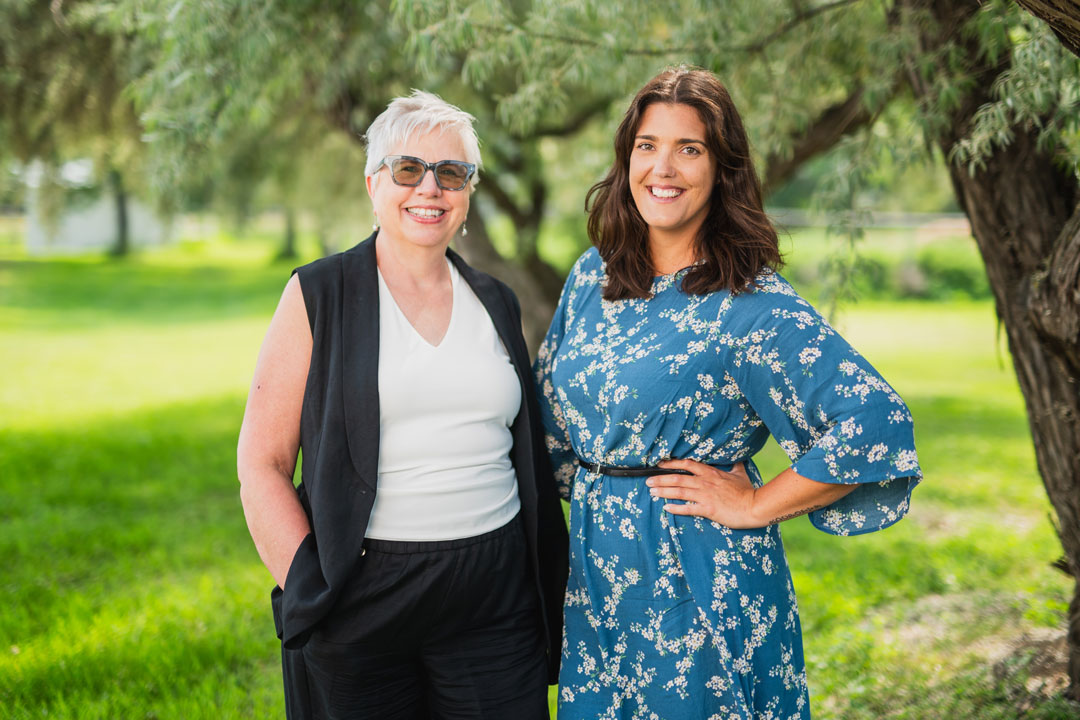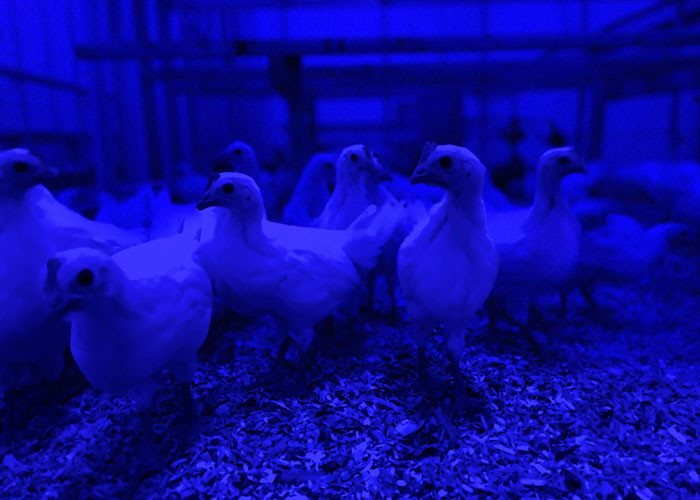
Groundbreaking research with global impact
USask’s Poultry Centre has helped improve industry standards across the world.
By Joanne PaulsonAll creatures on Earth — not just human beings — need to sleep, preferably in darkness.
While it seems a common-sense concept, empirical proof of this was lacking until relatively recently in the case of commercial poultry. It wasn’t until just a little more than a decade ago when Dr. Karen Schwean-Lardner (PhD) took up the case during her PhD project with Dr. Hank Classen (PhD).
Schwean-Lardner is now a professor and poultry scientist with a primary research focus on management and bird welfare at the Poultry Teaching and Research Unit at the University of Saskatchewan (USask) — usually referred to as the Poultry Centre. Her work (and that of others) has influenced global industry processes and policy in fundamental ways.
Schwean-Lardner’s PhD research began at a time when most chicken producers around the world provided their birds with 23 or 24 hours of light every day.
“Producers did not mean to mistreat the bird; there was a purpose,” Schwean-Lardner said. “The birds could feed, drink, move about and perform positive behaviours when they wanted to. I think they did it for very good reason.”
Yet perpetual light seemed questionable. And so, in conjunction with Aviagen, the largest broiler genetics company on earth, Schwean-Lardner dove in to investigate.
Using the Poultry Centre’s research barns, she provided various hours of darkness to different flocks and noted the effect on production, feed intake, bird welfare, meat yield, and other parameters.
“We think it all goes back to that biological cycling, that circadian rhythm, in birds,” she said. “They need to have a dark period. They need to sleep in a dark environment. We actually get better growth while significantly improving all aspects of bird welfare.”

Additional research done by Tory Shynkaruk, a research technician and Schwean-Lardner’s right arm, showed why the birds became more efficient.
“She’s worked on trying to figure out why feed efficiency is better, how feed transfers through the gut when we have different photoperiods. That helped us to explain what I saw in some of my PhD data.”
When you give the birds a dark period at the same time each day, they learn to anticipate it, Shynkaruk explained.
“They have an organ called a crop that can store feed. They’ll eat a lot before the onset of that dark period and fill that organ,” said Shynkaruk.
“During the dark period, there will be a slow release of food throughout. Their gastrointestinal tract never empties. My longest dark period was 10 hours, and yet their tracts were never empty because the birds anticipated that dark period, and ate more prior to lights going off.”
The lighting research has been adopted into practice by Aviagen and today, “their recommendations for every broiler they produce in the world is to include a dark period to allow birds to sleep,” said Schwean-Lardner.
“Approximately sixteen billion broilers are produced every single year world-wide and we’ve changed their well-being by the work that’s been done here.
“It’s also in our Canadian code of practice. We’re getting lots of interest in even further changing that. I think that would be our biggest influence.”
Where and why the work is done
The Poultry Centre’s research facility is made up of three separate buildings. The first contains the small hatchery used for research and for hatching the unit’s heritage stock. The other half of the building is the gnotobiotic unit used for germ-free research.
Further down the road are two long buildings. The nearest one is the brooding and rearing barn, which has nine mini-barns wherein the environments can be controlled and changed.
Across the way is another long barn, mainly a laying hen facility, with another smaller facility attached. When full, there are 16,000 birds on campus.
Schwean-Lardner points out that poultry is a massively important industry in this province.
“It’s an important component of our provincial as well as our national industry, because it’s very much locally produced,” she said.
“In Saskatchewan, the chances are very, very high that you will consume what is produced in our province. That’s different than the other industries (such as beef cattle), and I think that’s pretty cool.”
And more research
The Poultry Centre has also investigated other light-related elements of raising birds, including colour, intensity and flickering. Colour seems to make a difference in how chickens feel.
“How birds get light to the brain is different for them than it is for us. For a human, the light goes through the eyes and so it does with a chicken; but light also penetrates through the skull in birds. That activates components of the brain differently,” Schwean-Lardner said.
Red, for example, penetrates quite well; blue does not.
“But in broiler chickens (meat birds), blue light actually reduces fear and stress.
“The other project that’s interesting is our work with Dr. Trever Crowe (PhD) in transportation in Canadian environments. That’s another thing that’s unique to our university. Those are the two areas of research that have had the most important influences.”
Other research projects — among many — are being done by PhD students looking into commercial hatcheries as well as heat stress and how to mitigate it with feed composition.
The researchers are continuing the light colour work in other species.
“We’re just finishing up experiments studying leghorn pullets and commercial turkeys with respect to light wavelengths, and it appears to have different impacts in different species,” said Schwean-Lardner.
“We’re lucky, our group. We get to work with a lot of different species,” Shynkaruk said. “Other research groups tend to focus on one.”
There is less research occurring on turkeys generally, for example.
“It’s really exciting to be able to provide evidence on how to manage turkeys,” she said. “They’re a different breed.”
Raising turkeys is hard work, said Schwean-Lardner.
“They’re big strong birds, they’re curious birds, so they wreck things. They’re a whole different ballgame and we absolutely love them.”
Organizing all of this is by no means an easy feat, and as Schwean-Lardner said, “I wouldn’t get to do 90 per cent of the things I do if it weren’t for Tory.”
Shynkaruk is very busy juggling a myriad of tasks including writing grants, getting animal care approvals, managing the lab, overseeing student research, training students on procedures, and knowledge transfer.
“Sometimes we’ll get industry interest in doing projects and they don’t want to wait the two years that it can take a master’s student to finish and get that data through, so I’ll lead those projects to be able to get them the results they need at a faster pace,” she said.
Clearly, the Poultry Centre is always hopping; Schwean-Lardner alone has 11 graduate students.
And there are birds everywhere, always.
“June 1 was for me 10 years as a faculty member and those barns have been full with research all the time,” said Schwean-Lardner.

Consumer, producer and bird benefits
Benefits from the research have accrued across the board. For example, producers use and therefore pay for less electricity than in the past when proper lighting programs (including a dark period) are used.
“Canadian producers are amazing. They care about their animals. I’m very proud of our Canadian producers,” Schwean-Lardner said.
“With use of a dark period for broilers, producers can actually market more birds, heavier birds, and they eat less. Their welfare is so much better. They have a better life while they’re here.”
From a consumer perspective, in Canada, “you know the meat you are eating and the eggs you are consuming are coming from birds that have been treated well and have had a good life.”
And because better practices can help keep production costs down, that can help keep grocery store prices down.
“It’s really nice for us knowing there is work that can be directly applied on farm and can be benefiting producers or processors, and directly benefiting consumers,” Shynkaruk said.
As their research continues, so do advancements at the centre, which is in the planning and fundraising stages for a new laying hen facility.
“One of the very cool things that we want to do in that facility is have a glassed-in hallway that runs the length of the barn,” Schwean-Lardner said, “so that consumers, without risking biosecurity, without risking disease, can come in and walk through that hallway and see how those birds are being raised, and gain an understanding of where their food comes from.”
Among the centre’s primary focus is teaching and giving students the hands-on experience they can’t get elsewhere, she added.
“We are teaching the future leaders in the poultry industry. We have an incredibly strong link with our industry in Canada and internationally, and so much of our research applies to industry issues. It applies to farms all around the world. I love my job!”
Together, we will undertake the research the world needs. We invite you to join by supporting critical research at USask.

